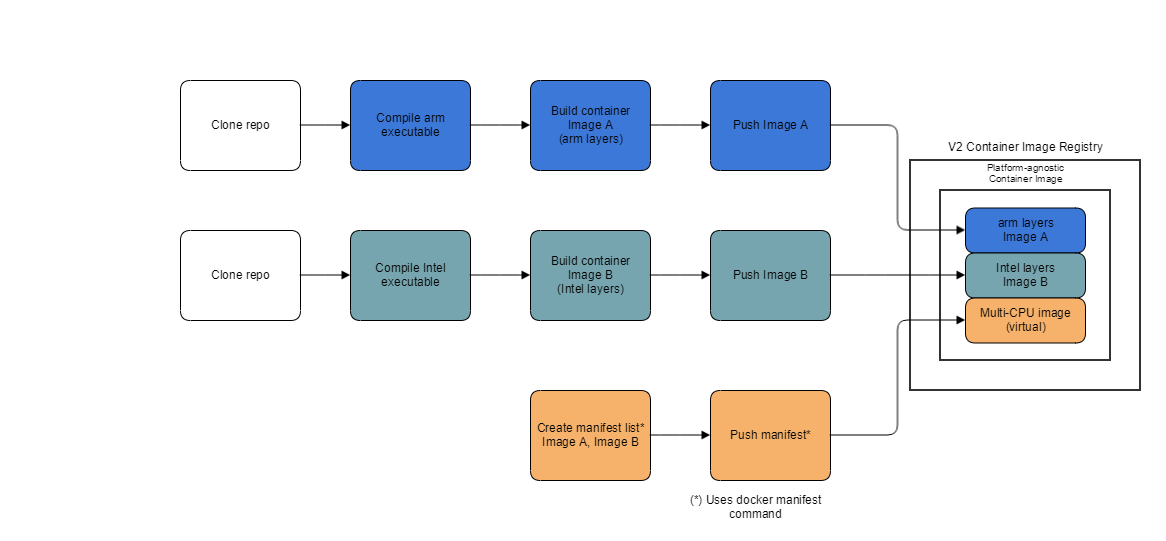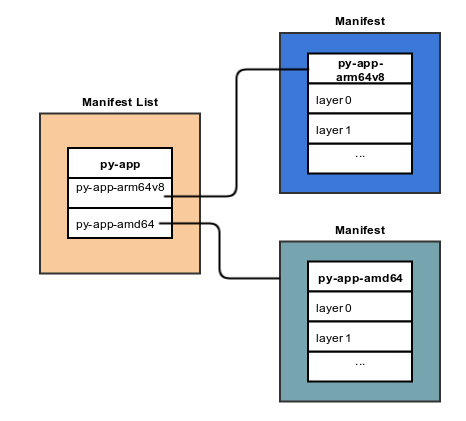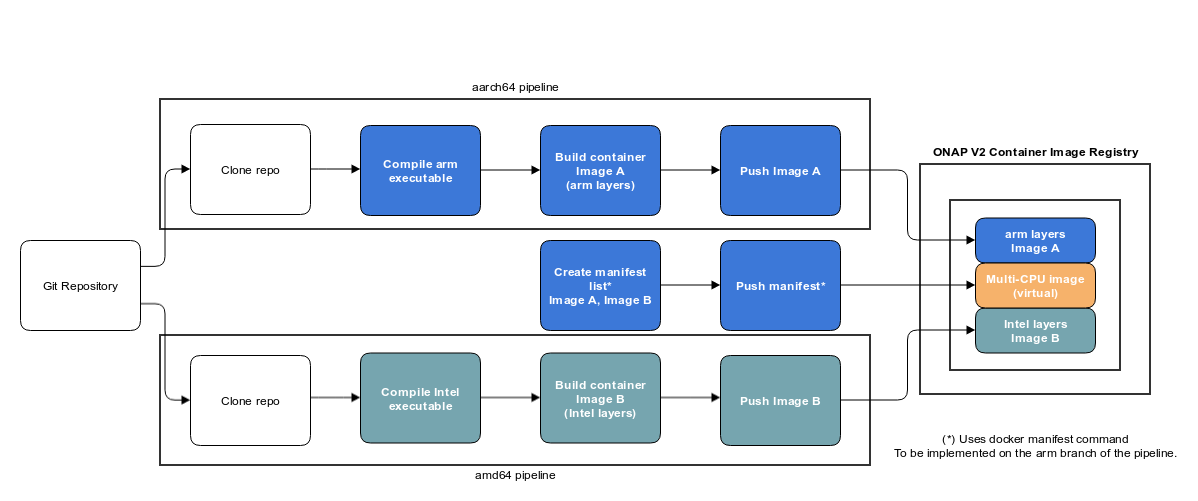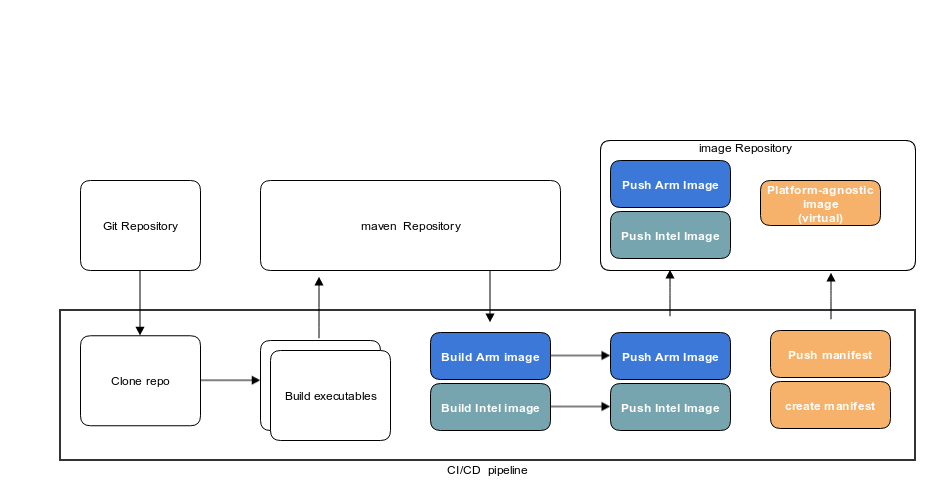Process
In general, the process to build a platform-agnostic container image follows the flow depicted on the following figure.
The commands needed to implement the flow are described, using an example, in the next section.

Example using a Python Micro-Service
Main steps
The following diagram captures the main steps we need to take to enable platform-agnostic containers:
(1) and (2) Build and push container images for each platform.
(3) Create and push a manifest list for the images above
(4) Pull and run the exact same image/tag on different platforms.

Manifest List and Image Layers
Digging a little bit deeper into step (4), the following diagram shows the relationship between a manifest list and image manifests for our platform-agnostic image (tag).

The following sections describe the commands needed to create a multi-cpu architecture container image. Let's call the image onap/py-app.
Note that this flow could be used by ONAP developers during the development-test-debug process.
For the release process, the flow will implemented using CI/CD pipelines as shown in the next section.
Source code
Code structure
. ├── app │ ├── main.py │ └── requirements.txt └── Dockerfile
Python App
from flask import Flask
import platform
app = Flask(__name__)
@app.route("/")
def hello():
return "Hello ONAP. I am a Python service running on " + platform.machine()
if __name__ == "__main__":
app.run(host='0.0.0.0', debug=True, port=5000)
Requirements
Flask==0.10.1
Dockerfile
FROM python:2.7-alpine LABEL maintainer="adolfo@orangemonk.net" # Keep it simple COPY ./app /app WORKDIR /app RUN pip install -r requirements.txt ENTRYPOINT ["python"] CMD ["main.py"]
Build arm image (A)
Log into an arm server, copy the code into the structure depicted above.
cd to the root of the code tree above, then execute
docker build -t onap/py-app-arm64 .
Push arm image to the registry
Once the image has been successfully built, push it to the repository.
Note that if you are using a private repository, you might need to "docker tag" the image before executing the next command.
docker push onap/py-app-arm64v8:latest
Build Intel image (B)
Log into an intel server, setup the code structure as before.
Let's now repeat the process for the intel layers of the multi-cpu container image.
docker build -t onap/py-app-amd64 .
Push Intel image to the registry
docker push onap/py-app-amd64:latest
Create a manifest list for image A and image B
Now that we have built and pushed layers for each cpu architecture, we can create the manifest list to put the final container image together with
docker manifest create onap/py-app \
onap/py-app-arm64v8 \
onap/py-app-amd64
Verify that the manifest describes a platform-agnostic container image.
docker manifest inspect --verbose onap/py-app
Verify that the manifest actually represents a multi-cpu architecture by looking at the different "platform" entries.
Notice how, in this case, the manifest shows layers for both arm and Intel cpu architectures.
[
{
"Ref": "docker.io/onap/py-app-amd64:latest",
"Descriptor": {
"mediaType": "application/vnd.docker.distribution.manifest.v2+json",
"digest": "sha256:4b1b8361d47770668ff4c728dc388f376158d9e8d82c0b4cdb22147cc8ca1be6",
"size": 1579,
"platform": {
"architecture": "amd64",
"os": "linux"
}
},
"SchemaV2Manifest": {
"schemaVersion": 2,
"mediaType": "application/vnd.docker.distribution.manifest.v2+json",
"config": {
"mediaType": "application/vnd.docker.container.image.v1+json",
"size": 6616,
"digest": "sha256:f2947f4a0e9d5d0a4ccf74a7b3ad94611a8921ca022b154cabcad9e453ea6ec5"
},
"layers": [
{
"mediaType": "application/vnd.docker.image.rootfs.diff.tar.gzip",
"size": 2206931,
"digest": "sha256:4fe2ade4980c2dda4fc95858ebb981489baec8c1e4bd282ab1c3560be8ff9bde"
},
{
"mediaType": "application/vnd.docker.image.rootfs.diff.tar.gzip",
"size": 308972,
"digest": "sha256:1b23fa3ccba56eced7bd53d424b29fd05cd66ca0203d90165e988fdd8e71fed7"
},
{
"mediaType": "application/vnd.docker.image.rootfs.diff.tar.gzip",
"size": 17711780,
"digest": "sha256:b714494d7662fbb89174690cefce1051117ed524ec7995477b222b8d96fb8f0c"
},
{
"mediaType": "application/vnd.docker.image.rootfs.diff.tar.gzip",
"size": 1776866,
"digest": "sha256:1098418f3d2f83bcccdbb3af549d75d9a5e9c37420e5c0d474fd84b022f6c995"
},
{
"mediaType": "application/vnd.docker.image.rootfs.diff.tar.gzip",
"size": 360,
"digest": "sha256:ca727cee7c2469ab6edb7ca86378985b3747938a325ddb7d90f3b85a3d14b34f"
},
{
"mediaType": "application/vnd.docker.image.rootfs.diff.tar.gzip",
"size": 4315553,
"digest": "sha256:767bbe8ba063767093b0350e8d1b86b438c677e3884c2a21851c00970d88317c"
}
]
}
},
{
"Ref": "docker.io/onap/py-app-arm64v8:latest",
"Descriptor": {
"mediaType": "application/vnd.docker.distribution.manifest.v2+json",
"digest": "sha256:8a06f997353177dae82d7e01bc3893b2f05c6ac27b317655df3ca2287f9b83a9",
"size": 1786,
"platform": {
"architecture": "arm64",
"os": "linux"
}
},
"SchemaV2Manifest": {
"schemaVersion": 2,
"mediaType": "application/vnd.docker.distribution.manifest.v2+json",
"config": {
"mediaType": "application/vnd.docker.container.image.v1+json",
"size": 6864,
"digest": "sha256:b097a21c92a9a0dde06f9b36bf10def56a028b3b9b1617d6d6c6a8559d14d9d7"
},
"layers": [
{
"mediaType": "application/vnd.docker.image.rootfs.diff.tar.gzip",
"size": 2099514,
"digest": "sha256:47e04371c99027fae42871b720fdc6cdddcb65062bfa05f0c3bb0a594cb5bbbd"
},
{
"mediaType": "application/vnd.docker.image.rootfs.diff.tar.gzip",
"size": 176,
"digest": "sha256:b4103359e1ecd9a7253d8b8a041d4e81db1ff4a5e1950bc0e02305d221c9e6c2"
},
{
"mediaType": "application/vnd.docker.image.rootfs.diff.tar.gzip",
"size": 308518,
"digest": "sha256:92079a442932f09a622f4a0f863e5cc2f6e0471a98e5121fa719d2a276440386"
},
{
"mediaType": "application/vnd.docker.image.rootfs.diff.tar.gzip",
"size": 18605961,
"digest": "sha256:f1fc35806f46347993a2cd1eb7f7dd7837b0bef0392c8e2c973b24c02ad874a9"
},
{
"mediaType": "application/vnd.docker.image.rootfs.diff.tar.gzip",
"size": 1786389,
"digest": "sha256:c2983ee3d71107a9a0bc1996fc3a58e050026995fad4aee9d72539153db1df3d"
},
{
"mediaType": "application/vnd.docker.image.rootfs.diff.tar.gzip",
"size": 391,
"digest": "sha256:44c3eae5ed66bb040727a64fd78573fe6cc4a94a9317d5cd6f39e53332c2ae21"
},
{
"mediaType": "application/vnd.docker.image.rootfs.diff.tar.gzip",
"size": 4305558,
"digest": "sha256:8daa79c3024a565c320ff69990ad48273937cc3f6f0cdb324e086c268cf6245e"
}
]
}
}
]
Push the manifest list to the registry
docker manifest push onap/py-app
Building Multi-CPU container images using CI/CD pipelines
The following diagram depicts a CI/CD flow that implements the production of multi-cpu architecture container images.
Although the flow shows a pipeline for two branches: arm-linux and intel-linux, the model can be extended --given the hardware and software resources-- to any number of platforms.

The following view illustrates intermediate step of building and storing executable and sequence of image processing

Intermediate Image Naming Convention
As described above, platform-agnostic support requires platform specific images that are put together to expose a multi-platform image. Platform architectures include, among others, arm,intel, mips, ppc64le, and s390x
These platform-specific image names are typically used only by developers that build the images. ONAP end users should only use the aggregate tag but can still inspect the image using docker manifest.
The following is the recommended naming convention for ONAP platform-specific images that will be produced by the different pipelines (<onap-image-name>). This convention is aligned with existing industry standards and naming conventions (amd64, arm64v8).
| Architecture | OS | Variant | Image Name |
|---|---|---|---|
| amd64 | Linux | <onap-image-name>-amd64 | |
| arm64 | Linux | v8 | <onap-image-name>-arm64v8 |
| mips | Linux | <onap-image-name>-mips |
Note: This table does not contain a exhaustive list of options and must only be used as an image naming guide. Because ONAP is vendor-agnostic, the list is not a statement of what architectures or OSs ONAP must support.
2 Comments
Keong Lim
As discussed on INT-769 - Getting issue details... STATUS , in order to support platform-specific bug-fixing, the user will need to report the specific container image actually being used.
Expectation is that they will "usually know what hardware they are using".
Alternately, an "ONAP developer" / "ONAP sysadmin" can run "docker version" and report the "OS/Arch" field, but an "ONAP user" won't have any indication from the UI, unless that info is also surfaced somewhere.
But, is there also a possibility of heterogeneous environment, e.g. multiple CPU-architectures in the same kubernetes cluster or different CPU-architectures across multiple clouds?
Paul-Ionut Vaduva
In most of the cases (I haven't examined exhaustively all the projects) the CI part of the pipeline builds the executables (java, python, sometimes native ocde as well) and if successfull pushes the executables rexulted to maven repos, and the CD part of the pipeline (which is represented here just copies the executables built as part of the CI jobs.
Because the resulted executables are java for the great majority of the CI jobs we haven't duplicated the CI jobs on arm64 servers as (idealy) the result would be the same executables for java or python (everything with a VM). If the result is not the same then there is a shortcoming of the porting of the java, python VM on the arm64 architecture and I don't think we want / can go into that (maybe just reporting bugs).
The java executables have in some ocasions invocations of native code (libs) which is saved / copied in the jar archives. java has cpu detection mechanisms and in most ocations the arm64 support is just adding the necesary lib according to architecture.
Simply put I think we should modify the Compile arm executable and Compile intel executable with Copy executable (from maven repo) which should have multi cpu support.(the previous longer discusion)